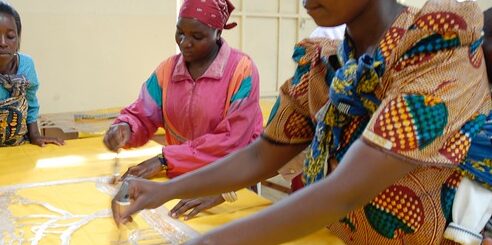Consultancy for Adapted Semi-Qualitative Evaluation of Access and Coverage (SQUEAC) survey in Marsabit & Isiolo County (a follow-up to a baseline SQUEAC in 2021)
1. Background and Context
The prevalence of global acute malnutrition (GAM) among children under-five remains persistently high in the Arid and Semi-Arid Lands (ASAL) of northern Kenya, despite improvements in other areas of Kenya over recent years. Marsabit and Isiolo counties are among the most affected of the ASALs. In both counties, the GAM prevalence has been at either the critical (15%–29.9%) or serious (10%–14.9%) phase of acute malnutrition based on the Integrated Phased Classification (IPC) according to annual surveys for most of the past ten years (2010 – 2019).[1]
[1] Nawiri Malnutrition Hotspots Mapping & Analysis in Marsabit County of Kenya and in Isiolo County Kenya. Final Report. Catholic Relief Service (CRS), USAID, Nairobi, Kenya
Coverage of services for severe acute malnutrition (SAM) and moderate acute malnutrition (MAM) has been sub-optimal for much of that period. Despite progress, many challenges remain and surveys indicate that only between half and two-thirds of children suffering from acute malnutrition are accessing essential treatment in ASAL areas.[2]
To combat persistent levels of child wasting/ acute malnutrition, the USAID-funded Nawiri project has been designed to investigate the drivers of malnutrition in the ASAL contexts and to implement integrated, multi-sectoral interventions to address them over a five-year period (2019 – 2024). The project is jointly implemented by the County and Sub-county governments and a consortium of eight non-governmental partners.[3] The project is targeting primarily four vulnerable sub-counties in Marsabit County (North Horr sub-county, Laisamis sub-county) and Isiolo County (Garbatula sub-county and Merti sub-county), as well as some additional wards in neighboring sub-counties that have been identified as malnutrition hotspots according to analysis undertaken by Nawiri partners in 2021.[4] The communities are predominantly pastoralist and engage in regular movements to access pasture and water for their herds (largely camel, cattle and goats).
In Kenya, services for the integrated management of acute malnutrition (IMAM) are provided at health facilities as part of the package of essential health services. The IMAM Surge approach was developed in Marsabit County (Moyale) in 2012 as an approach to help health facility and county/ sub-county teams better anticipate, prepare for and manage cases of acute malnutrition during periods when caseloads peak or ‘surge’. The approach has eight steps, but essentially involves reviewing past caseloads and seasonal calendars to anticipate when caseloads of SAM/ MAM will peak; setting caseload thresholds above which the health facility team would struggle to provide quality care; agreeing actions (from health facility team) and support needed (from sub-county/ county) when those thresholds are passed; monitoring caseloads and triggering that support when thresholds are crossed; then returning to normal, reflecting and adjusting for the next surge season. For more on the IMAM Surge approach in Kenya please see this article in the Field Exchange and for more on the CMAM/ IMAM Surge approach generally, please see additional articles in the Field Exchange and the Concern CMAM Surge website.
The Kenyan government adopted the IMAM Surge approach in 2015 and has since been scaling it up across the ASALs where acute malnutrition generally follows quite a seasonal pattern. Peaks in malnutrition occur largely during the dry seasons when (Jan-Feb and Jun – Aug) when animals are in distant pastures/ watering locations and therefore furthest from the homestead and young children, food prices are highest, and access to water is limited.
The IMAM Surge approach has been deemed highly relevant and useful in Kenya among health staff and other key stakeholders.[5] However, three potential improvements were identified for further testing and refinement: 1) applying the same approach to seasonal child illnesses, alongside acute malnutrition – in the ASAL context this is largely diarrhea and acute respiratory infection 2) expanding the set of surge actions which are usually focused on service delivery at the facility to trigger community level screening e.g. when admissions are lower than what would be expected during the ‘surge period’ and 3) engaging communities to engage in simple actions at certain times of the year to prevent the peak or surge in caseloads from occurring in the first place.
Under the Nawiri project, Concern and the County and Sub-county government teams in the four target sub-counties of Marsabit and Isiolo Counties have been piloting the above three adaptions to the IMAM Surge approach to determine which elements should be take forward for scale up in the latter half Nawiri implementation. Each was carried out over a 12-month period (April 2021 – March 2022) in a subset of health facilities and the community units attached to them. The three pilot ‘arms’ were: 1) ‘Health Surge’ – applying the Surge approach to ARI and diarrhea (12 facilities); 2) ‘Community Screening Surge’ – triggering community level screening based on admissions for acute malnutrition (11 facilities)[6]; 3) ‘Preventative Actions Surge’ – supporting communities to engage in seasonal actions to prevent new cases of acute malnutrition (8 facilities).
Coverage of treatment services for acute malnutrition is a key indicator in assessing the added value of the three IMAM Adaptations during the pilot. A SQUEAC was carried out in August/ September 2021 to establish a ‘baseline’ for the pilot phase. The baseline results were as follows:
- County: Marsabit ; Sub-county: North Horr
Areas covered (all 3 pilot arms combined): 12 health facilities/ catchment areas
Results: OTP: 54% (40%-67%); SFP: 44% (37-51%)
Comparison by pilot arm: Health: high (>50%) for OTP; low (<50%) for SFP ; Community Screening: moderate (=50%) for OTP; low (<50%) for SFP; Preventative Actions: moderate (=50%) for both OTP and SFP
- County: Marsabit; Sub-county: Laisamis
Areas covered (all 3 pilot arms combined): 13 health facilities/ catchment areas
Results: OTP: 39% (28-51%); SFP: 49% (43- 55%)
Comparison by pilot arm: Not available, sample too small
- County: Isiolo; Sub-county: Garbatula
Areas covered (all 3 pilot arms combined): 3 health facilities / catchment areas
Results: OTP: 33% (20-50%); SFP: 30% (21-41%)
Comparison by pilot arm: Not available, sample too small
- County: Isiolo; Sub-county: Merti
Areas covered (all 3 pilot arms combined): 3 health facilities/ catchment areas
Results: OTP: OTP: 25% (15-41%); SFP: 16% (11-24%).
Comparison by pilot arm: Not available, sample too small
Concern is now seeking a qualified consultant to carry out a follow up assessment in roughly the same area with some adaptations as outlined below.
2. Objective of the Consultancy
The main objective is to carry out an adapted SQUEAC survey to assess the coverage of IMAM services in the communities targeted for the adapted IMAM Surge pilot during the previous 12 months (April 2021 – March 2022) in Marsabit, particularly those targeted for the Community Screening Surge adaptation.[7] The aim is to determine if any changes in coverage have occurred during the pilot period and to understand the degree to which the barriers identified at baseline have been addressed (if at all) by the adapted approach.
Specific objectives
- To estimate the treatment coverage of children 6-59 months with severe acute malnutrition (SAM) and moderate acute malnutrition (MAM) in the 12 health facilities/catchment areas targeted for the Community Screening Surge pilot in Marsabit, providing a reliable single coverage estimate and confidence interval.
- To classify the level of coverage in the Health Surge pilot arm (11 facilities) and Preventative Actions Surge pilot arm in Marsabit (8 facilities) as low (<50%), medium (=50%) or high (>50%)
- To identify factors affecting uptake of SAM and MAM services in the pilot areas (barriers and boosters) and determine the degree to which barriers identified have been addressed (if at all), according to the action plans developed at baseline.
- To understand from health facility staff and Community Health Volunteers (CHVs) in the Screening Surge and Preventative Actions Surge pilot what actions were planned and triggered and when and where during the previous twelve months of the pilot.
- To strengthen the skills of technical staff (MOH and Concern/Nawiri) in the SQUEAC methodology through training and mentorship.
- In collaboration with the MOH teams in two Counties, Nawiri and other nutrition partners in the area, provide specific recommendations on how the Screening Surge pilot components and Preventative Actions pilot components could be improved to increase coverage in the future using the Adapted IMAM Surge approach.
3. Justification
Concern is the lead partner for health and nutrition in the Nawiri consortium and for piloting the Adapted IMAM Surge approach in Isiolo and Marsabit Counties, which will inform the final approach to implementation during the remainder of the project. Assessing IMAM coverage requires specialized skills. Thus, Concern seeks the service of an experienced consultant to adapt the SQUEAC methodology and conduct the assessment in Marsabit County.
4. Technical Approach and Methodology
Specific tasks to be undertaken by the consultant
The following should be undertaken in collaboration and support from Concern/ Nawiri and County/ sub-county health authorities:
- Survey method: Work with the Concern and MoH team (and potentially external experts) to confirm the final survey methodology vis-à-vis the context of the IMAM Surge pilot and baseline survey method and results, ensuring robust comparisons can be made according to the specific objectives above.
- Tools: Develop and review the data collection tools.
- Training: Train data collectors for the assessment. Transfer skills in undertaking a SQUEAC assessment to Concern staff, MOH staff and recruited SQUEAC data enumerators to equip them with skills to undertake a SQUEAC coverage assessment.
- Administration: Supervise the full coverage survey (survey planning, data collection and analysis, and reporting) in all the targeted areas of operation.
- *Implementation of survey: Lead in the organization and implementation of the actual survey: with support from Concern technical and MoH staff, ensure accurate data collection at field level. Ensure adequate supervision and coordination of the survey teams in the field.
- Data processing and management; ensure accurate information is collected and analysis of all data is done with the team using all existing and new information available.
- Reporting and dissemination: provide regular/scheduled updates via power point presentations to the NITWG at different stages of the SQUEAC assessment for quality checks. During dissemination and validation workshops of the survey the consultant will present the results to the Nutrition Information Technical Working Group (NITWG) and the appropriate County Nutrition Forum.
- Action planning: In collaboration with Nawiri/Concern lead a one day workshop for MOH staff and partners working in the two counties to develop specific recommendations to improve coverage of CMAM program in the target areas, including practical adaptations to the IMAM Surge approach for the next phase of Nawiri implementation.
5. Outputs and Deliverables
The following are the deliverables expected of this assignment
- An inception report outlining the methodology, teams and resources needed and final timeline to be followed
- Concise SQUEAC assessment report with executive summary
- Power point presentation outlining the methodology and preliminary findings for dissemination during the NITWG and County forums
6. Timeframe
The proposed consultancy will last for 30 days (including training, data collection and technical report). A proposed work schedule will be developed and agreed with the consultant. The expected time for the assessment will be in May/June 2022.
7. Remuneration
- Concern will pay the consultant a fee per day for the agreed number of days required for the work.
- Please indicate the number of days required (share a detailed work plan) and your daily rate in the proposal.
- The payment is subject to withholding tax and other requirements under the Laws of Kenya.
- In your quotation clearly indicate if VAT is applicable or not.
8. Working Conditions
The Consultant is expected to work at the direction of Concern. Internally s/he will closely work with Concern NAWIRI team – Project Lead, Senior Advisor-Health and Nutrition, and Nutrition Technical Specialists. Externally, the Consultant will interact with other NAWIRI partners that includes Tufts University and Catholic Relief Services among other consortium members. At the county level, the consultant will liaise and engage with County Nutrition Officers/ Coordinators in Marsabit (and possibly Isiolo) County. Further, this assessment involves interaction with Ministry of Health (MOH) and other national government departments and officials.
9. Essential Qualifications
- Extensive experience conducting IMAM coverage surveys, including SQUEAC and/or SLEAC and training and supervising teams on the approach.
- Post graduate qualification in nutrition or related health science,
- At least 3 years’ experience working in the humanitarian/ development sector and conducting similar assessments.
- A strong understanding of the statistical basis for SQUEAC and SLEAC in order to guide the team on the best method to use for the needs outlined above.
- A very good command of spoken and written English.
- Consultants and consultancy firms based in Kenya with solid experience in the health and nutrition sector in Kenya are encouraged to apply.
- Previous experience in the ASALS will be an added advantage
10. Supporting documentation required
- Certificate of Incorporation (firms) or National ID card (individual)
- Valid Tax Compliance Certificate
- PIN Certificate
- Company / Consultant’s Profile
- CVs of key staff
- Certificate/reference information of previous undertakings of similar contracts with NGOs/UN agencies.
- Safeguarding Policy, Code of Conduct etc. or what are the necessary provisions have you put in place to keep everyone safe in the course of your engagement.
- Attach copy of Certificate of Good Conduct or proof that you have applied for the same.
- Confirm the gender ratio for the team that you will be engaging in this exercise.
- A detailed work plan with milestones.
11. Safeguarding at Concern: Code of Conduct and its Associated Policies
Concern has an organizational Code of Conduct (CCoC) with three Associated Policies; the Programme Participant Protection Policy (P4), the Child Safeguarding Policy and the Anti-Trafficking in Persons Policy. These have been developed to ensure the maximum protection of programme participants from exploitation, and to clarify the responsibilities of Concern staff, consultants, visitors to the programme and partner organization, and the standards of behaviour expected of them. In this context, staff have a responsibility to the organization to strive for, and maintain, the highest standards in the day-to-day conduct in their workplace in accordance with Concern’s core values and mission. Any candidate offered a consultancy opportunity with Concern Worldwide will be expected to sign the Concern Code of Conduct and Associated Policies as an appendix to their consultancy contract. By signing the Concern Code of Conduct, candidates acknowledge that they have understood the content of both the Concern Code of Conduct and the Associated Policies and agree to conduct themselves in accordance with the provisions of these policies. Additionally, Concern is committed to the safeguarding and protection of vulnerable adults and children in our work. We will do everything possible to ensure that only those who are suitable to do consultancy work or volunteer with vulnerable adults and children are recruited by us for such roles. Subsequently, being hired as a consultant with Concern is subject to a range of vetting checks, including criminal background checking.
Concern’ is the trading name of ‘Concern Worldwide’, a company limited by guarantee, registered number 39647; registered charity number CHY 5745, registered in Ireland, registered address is 52-55 Lower Camden Street, Dublin 2, Ireland. Follow Concern online: www.concern.net
Please submit a proposal stating your interest, the basic methodology/ steps to be taken, expected number of days to complete the work and the daily consultancy fee per day. Please submit via email to consultancies.kenya@concern.net, with subject line “SR93813 – Adaptive SQUEAC Survey” by 4:00pm, 6th May 2022.
Concern Worldwide does not charge a fee at any stage of recruitment process.








